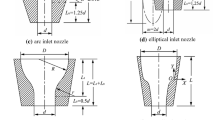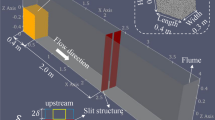Abstract
We observed variations in collection efficiency and wall loss in a virtual impactor by applying a horizontal inlet. A parametric study on the dimensions of the horizontal inlet was conducted to determine the shape that could maximize the collection efficiency and minimize the wall loss. As a conventional vertical inlet was replaced by a horizontal inlet, the PM2.5 virtual impactor decreased the cut-off size by 17 % from 2.5 μm to 2.08 μm while the PM10 virtual impactor decreased the cut-off size by 22 % from 10 μm to 7.8 μm. The application of a horizontal inlet significantly reduced the wall loss for a particle size corresponding to a particular cut-off size, overcoming the problem with the existing virtual impactor.
Similar content being viewed by others
References
J. Douwes, P. Thorne, N. Pearce and D. Heederik, Bioaerosol health effects and exposure assessment: Progress and prospects, The Annals of Occupational Hygiene, 47 (2003) 187–200.
J. W. Choi, C. H. Ahn, S. Bhansali and H. T. Henderson, A new magnetic bead-based, filterless bio-separator with planar electromagnet surfaces for integrated bio-detection systems, Sensors and Actuators B, 68 (2000) 34–39.
M. Wubulihairen, S. Y. Jiang and Z. Ning, Prototype development and laboratory evaluation of an aerosol to hydrosol sampler, Aerosol and Air Quality Research, 15 (2015) 776–785.
S. Kim, P. A. Jaques, M. Chang, J. R. Froines and C. Sioutas, Versatile aerosol concentration enrichment system (VACES) for simultaneous in vivo and in vitro evaluation of toxic effects of ultrafine, fine and coarse ambient particles Part I: development and laboratory characterization, Journal of Aerosol Science, 32 (2001) 1281–1297.
T. Han, H. Zhen, D. E. Fennell and G. Mainelis, Design and evaluation of the field-deployable electrostatic precipitator with superhydrophobic surface (FDEPSS) with high concentration rate, Aerosol and Air Quality Research, 15 (2015) 2397–2408.
D. Park, Y. H. Kim, C. W. Park, J. Hwang and Y. J. Kim, New bio-aerosol collector using a micromachined virtual impactor, Journal of Aerosol Science, 40 (2009) 415–422.
S. H. Mirhoseini, M. Nikaeen, K. Satoh and K. Makimura, Assessment of airborne particles in indoor environments: applicability of particle counting for prediction of bioaerosol concentrations, Aerosol and Air Quality Research, 16 (2016) 1903–1910.
P. Biswas and R. C. Flagan, The particle trap impactor, Journal of Aerosol Science, 19 (1988) 113–121.
R. F. Hounam and R. J. Sherwood, The cascade centripeter: a device for determining the concentration and size distribution of aerosols, American Industrial Hygiene Association Journal, 26 (1965) 122–131.
Y. A. Hassan, B. G. Jones and T. J. Yule, Analytical study of virtual impactor aerosol separators, Transactions of the American Nuclear Society, 33 (1979) 182–184.
V. A. Marple and C. M. Chien, Virtual impactors: A theoretical study, Environmental Science and Technology, 14 (1980) 976–985.
B. W. Loo and C. P. Cork, Development of high efficiency virtual impactors, Aerosol Science and Technology, 9 (1988) 167–176.
Y. Ding and P. Koutrakis, Development of a dichotomous slit nozzle virtual impactor, Journal of Aerosol Science, 31 (2000) 1421–1431.
H. Lee, D. H. Jo, W. G. Kim, S. J. Yook and K. H. Ahn, Effect of an orifice on collection efficiency and wall loss of a slit virtual impactor, Aerosol Science and Technology, 48 (2014) 121–127.
J. H. Kim, G. W. Mulholland, S. R. Kukuck and D. Y. H. Pui, Slip correction measurements of certified PSL nanoparticles using a nanometer differential mobility analyzer (Nano-DMA) for Knudsen number from 0.5 to 83, Journal of Research of the National Institute of Standards and Technology, 110 (2005) 31–54.
W. C. Hinds, Aerosol technology: Properties, behavior, and measurement of airborne particles, Second Ed., John Wiley, New York, USA (1999).
T. H. Hwang, S. H. Kim, S. H. Kim and D. Lee, Reducing particle loss in a critical orifice and an aerodynamic lens for focusing aerosol particles in a wide size range of 30 nm -10 μm, Journal of Mechanical Science and Technology, 29 (2015) 317–323.
G. Sung, C. Ahn, A. Kulkarni, W. G. Shin and T. Kim, Highly efficient in-line wet cyclone air sampler for airborne virus detection, Journal of Mechanical Science and Technology, 31 (2017) 4363–4369.
Author information
Authors and Affiliations
Corresponding author
Additional information
Recommended by Associate Editor Seong Hyuk Lee
Ji-Eun Heo received the B.S. degree from the School of Bioindustial Mechanical Engineering, Chonbuk National University, Republic of Korea, in 2016. She is currently a M.S. student at Hanyang University, Republic of Korea. Her research interests include aerosol technology.
Muhammad Zeeshan Zahir received the B.S. degree from the Department of Mechanical Engineering, University of Engineering and Technology, Peshawar, Pakistan, in 2011. He is currently a Ph.D. student at the Hanyang University, Republic of Korea. His research interests include aerosol technology.
Hyunjin Park received the B.S. degree from the School of Mechanical Engineering, Hanyang University, Republic of Korea, in 2017. His research interests include heat transfer and aerosol technology.
Jeonghyun Seo received the B.S. degree from the School of Mechanical Engineering, Hanyang University, Republic of Korea, in 2017. His research interests include heat transfer and aerosol technology.
Hyeongjun Park received the B.S. degree from the School of Mechanical Engineering, Hanyang University, Republic of Korea, in 2017. His research interests include heat transfer and aerosol technology.
Se-Jin Yook received the Ph.D. degree from the Department of Mechanical Engineering, University of Minnesota, USA, in 2007. He is currently an Associate Professor at the School of Mechanical Engineering, Hanyang University, Republic of Korea. His research interests include heat transfer and aerosol technology.
Rights and permissions
About this article
Cite this article
Heo, JE., Zahir, M.Z., Park, H. et al. Effect of horizontal inlet on slit-nozzle virtual impactor performance. J Mech Sci Technol 32, 2419–2424 (2018). https://doi.org/10.1007/s12206-018-0454-8
Received:
Revised:
Accepted:
Published:
Issue Date:
DOI: https://doi.org/10.1007/s12206-018-0454-8




